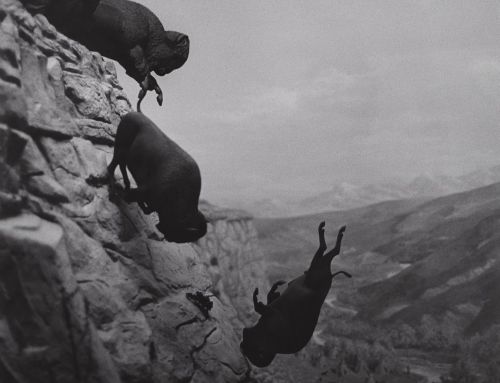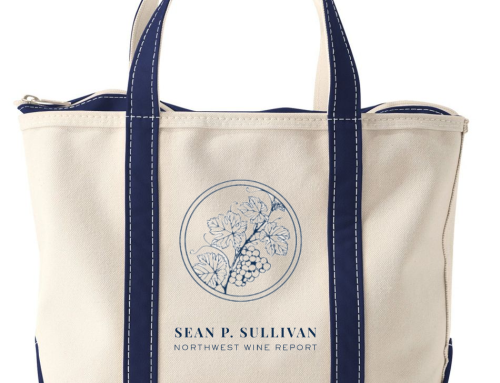What follows is a Focus report on Gramercy Cellars. This report is available as a .pdf here.
In a very short time, Gramercy Cellars has evolved from a start-up winery with its inaugural release in 2007 to one of the most exciting wineries in Washington. Since that time, Gramercy’s winemaker Greg Harrington has released two exceptional vintages, has been named Washington’s best new winemaker by Seattle Magazine, and has had his 2005 Lagniappe Syrah listed among “the most exciting red wines being made in America today” by the Wall Street Journal. Long time readers of Washington Wine Report may remember that in my 2007 Walla Walla Holiday Barrel Tasting report, I stated that Gramercy would be a winery to watch and that their 2005 Lagniappe Syrah was one of my 2008 Wines of the Year. If you are looking for a bandwagon on which to jump, now would be the time.
Greg Harrington is one of a small number of winemakers redefining Washington syrah. Harrington began making wine in Walla Walla in 2005. Prior to arriving in Washington, he managed wine programs for the likes of Emeril Lagasse and Wolfgang Puck. This experience provided him with knowledge of world wine that is often sorely lacking in Washington. While Harrington had originally thought of making wine as a later-in-life activity, he quickly accelerated that plan after traveling to Walla Walla in 2004. Harrington’s initial releases included a 2005 Walla Walla Valley Syrah and a 2005 Lagniappe Syrah. Pronounced LAN-yap it is a French American term for “a little something extra” in a nod to his time in New Orleans. Also released was a 2005 Tempranillo, a Spanish grape that is the principle component of Rioja. While all received accolades, it is the syrah that he quickly became known for.
Throughout the decade, syrah has been on the rise in Washington. Syrah’s ascendancy has been inspired both by continued experimentation by the state’s winemakers and by a desire to find Washington’s signature varietal. Much as Napa says cabernet and Australia says shiraz, winemakers have been searching for the one varietal that people will think of when they think Washington wine. In syrah, some think they might have found it. A number of producers have had success with syrah. These include Betz Family Winery, Dunham Cellars, McCrea Cellars, DeLille Cellars, and perhaps most notably, Walla Walla’s Cayuse and K Vintners. However, syrah’s rise in Washington has not been without bumps.
While in 2001 New York Times wine writer Eric Asimov called Washington syrah an “up and coming star,” he amended that statement in a 2005 article “Waiting for Washington Syrah.” Tasting a series of 2002 vintage wines Asimov stated “Instead of distinctive wines that we could identify as syrah, we found big, unbalanced wines full of the flavors of oak and baked fruit.” Last summer Wine Press Northwest stated that interest in Washington syrah was waning as the wines had become softer, more alcoholic, and expensive. Most recently, in a Washington Post column titled “The Trouble with Syrah”, Dave McIntyre noted that “Too many American syrahs…are syrupy monsters with alcohol levels often exceeding 15 percent.” McIntyre, mentioning Washington wineries among others, goes on to admonish “Winemakers need to stop deadening our palates with excessive alcohol and learn to leave the finesse in the wine.” This might seem excessively harsh. I assure you it is not.
Several years ago I had more or less given up on Washington syrah. This is not to say that I did not try some from time to time, but I generally found few in my cellar and, when going to tastings, often skipped over the varietal. At best, I just did not find them all that interesting. At worst, they were heavy handed and uneven. Many smelled like the fruit had been hit with a blowtorch. When the aroma didn’t come off as burnt, the tastes were often leaden with oak and heavy with alcohol. Gone from them was any sense of place, time, or varietal characteristics. When asked what Washington syrah tastes like, my response would be “I would love to find out if I could get past the burnt fruit and alcohol.”
This is where Gramercy Cellars comes in. Harrington’s knowledge of world wine allows him to craft wines that fulfill the promise of Washington syrah – wine that retains its varietal characteristics and straddles neatly the Old World and the New. As with all winemakers, Harrington seeks balance between fruit, acidity, and oak influence. He just has a very different sense of where that balance lies than many in the New World. Gramercy Cellars’ wines are driven by acidity rather than tannins. This is not to say the wines lack tannins. They just do not hit you over the head with tannins. The alcohol levels of all of Gramercy’s wines are mercifully between 13.5 to 14 percent. While the fruit is ripe, unlike many Washington syrahs, it is not overripe as Harringon picks his fruit earlier than many in the state. Gramercy also eschews the use of abundant new oak, preferring instead to focus on the fruit and the land it comes from. Lovers of what Gary Vaynerchuck calls the “oak monster” should look elsewhere. Harrington describes his philosophy as “minimalist winemaking.” The Wall Street Journal perhaps says it best when describing the 2005 Lagniappe Syrah as though it “Tastes like delicious grapes pressed into wine and left alone.” As a result of all this, both the fruit and the land, let’s say it together, the terroir shows through in a way seldom seen in Washington.
In addition to going easy on the new oak, Harrington also puts a fair percentage of whole cluster grapes (yes stems and all) into the fermentation process. Use of the stems gives the wine increased acid, tannins, and a fuller mid-palate. Winemakers wanting to try this beware. Harrington notes that if the stems are damaged during the process, the result can turn the wine green like “Kermit the Frog.”
To get the delicious grapes, Harrington is sourcing fruit from a number of exceptional vineyards, including Les Collines, Pepper Bridge, and Forgotten Hills in the Walla Walla AVA; Portteus and Minnick in the Columbia Valley; and Phinny Hill in Horse Heaven Hills. Gramercy is also sourcing fruit from their estate vineyard south of downtown Walla Walla. While focusing his initial releases on syrah and tempranillo, Harrington has branched out to include a small bottling of pinot noir and a cabernet sauvignon (just released). Grenache will be added in the future.
In addition to Gramercy Cellars, Harrington partners with Jamie Brown of Waters Winery in two other winemaking ventures – Wines of Substance and 21 Grams. Wines of Substance focuses on high quality, single varietal wines at an affordable price point. The idea, at least in part, is to entice and educate younger consumers. In terms of enticement, the winery uses a flashy website and eye catching black and white labels with periodic table-style elemental symbols, such as Me for Merlot. For education, the website contains descriptions of each varietal and the aromas and flavors associated with it. The 21 Grams venture, which Harringon also shares with Jamie Brown, currently makes one wine, a high end cabernet-dominant Bordeaux-blend. Less than 100 cases of this wine are produced and the results thus far have been exceptional. The inaugural release, the 2005 vintage, was also among my top wines of 2008. The 2007 vintage, sampled here, will be released in 2010 (Note: The 2006 vintage will be released in May of 2009).
At the beginning of March, Greg and his wife Pam invited me to their home in Seattle for lunch to taste through their latest and upcoming releases. Greg and Pam strike a dynamic couple. For someone who has experienced an enormous amount of success, Greg is surprisingly soft-spoken and unassuming. His confidence is a quiet one. Greg’s passion for wine is immediately apparent both from the excitement with which he speaks about it and the intensity on his face while he evaluates his wine. While proud the way a father is with a child, like many fathers he is more likely to note in his wines the things he would like them to do better than express satisfaction. Greg is as comfortable in the kitchen as he is making wine, a sign of his years working in the restaurant industry. For lunch he made a simple yet elegant meal of braised meat, spaghetti with coarsely ground black pepper, and a spinach salad. With Gramercy’s wines clearly crafted to be consumed with food, the pairing was perfect.
Pam, who works as a private equity recruiter, is as effusive as Greg is reserved. Gramercy’s website affectionates ribs “Although no stranger to a wine bottle, Pam Harrington would not be categorized as a wine expert.” Indeed, Pam describes herself more as wine lover than afficionado. The winery is dedicated in part to Pam’s father, John Lewis Plummer. Having passed away in 1999, Gramercy’s reserve syrah bears his name in tribute. Pam speaks of her father frequently and fondly throughout the afternoon. “Pass me Dad’s wine!” Pam says as we enjoy our lunch.
Lest anyone reading this thinks owning a winery and making wine is all romance and fun, during the year, Greg splits his time between their home in North Queen Anne and Walla Walla. Although Pam swears the drive can be done in three and a half hours, most find it to be more like four and a half. For the occasional long weekend, it can be a lengthy drive. As a commute, it can be grueling.
Throughout the afternoon – and into the evening – we tasted through wines spanning Gramercy Cellars’ first four vintages. We also touched on wines from the Substance and 21 Grams projects. The Gramercy wines included the latest releases from the 2006 vintage – Walla Walla Valley Syrah; Lagniappe Columbia Valley Syrah; John Lewis Reserve Syrah; Tempranillo, and Cabernet Sauvignon. We tasted some of the building blocks of what will become Gramercy’s 2007 syrahs to be released this fall – including syrah from Forgotten Hills Vineyard and two different blocks of syrah from Les Collines Vineyard. We also took an early look at some of the 2008 cabernets which recently finished fermentation (Note: Due to their very young age, I have provided notes about these wines but have not rated them). We finished up by returning to the 2005 wines to see how they were aging.
In tasting through these wines, it is fair to say that Gramercy Cellars flips on its head the way you think about Washington wine in general and Washington syrah in particular. The use of mostly neutral oak provides a purity of fruit that is simply breathtaking. Indeed, written throughout my notes about each wine was a notation about the purity of the fruit. The neutral oak also allows beautiful earth tones that might otherwise be overwhelmed to emerge. Over time, as the fruit ages, the earth tones will come to the fore, a reason to tuck a few bottles far back in the cellar. The cabernet, with aromas and flavors reminiscent of Dunham’s Lewis Vineyard offering, is an exceptional addition to Gramercy’s lineup.
Subsequent to this tasting Harrington bottled his 2007 syrahs. For the John Lewis Reserve Syrah, Harrington states that he went “balls out” fermenting the Les Collines grapes 100% on stems saying “I find that I can’t make great Syrah until it scares the crap out of me.” About 150 cases of this wine will be produced. The 2007 Lagniappe will be a blend of syrah from Forgotten Hills Vineyard Clone 99 (tasting notes below) blended with Minnick Vineyard syrah. Harrington says that this wine will take forever to open but that patience will be rewarded. About 200 cases of this wine will be produced. These wines will be released in the fall of 2009.
The 2007 Walla Walla Valley Syrah will be a slight departure from the previous two releases. Previously the fruit for this wine has been solely from Les Collines Vineyard. For the 2007 release, the Les Collines fruit will be blended with fruit from Forgotten Hills (Phelps Clone as opposed to Clone 99 in the Lagniappe). Harrington states “I was never convinced Les Collines and Forgotten Hills would go together. It made sense in my head, but never tasted how I wanted it. But I realized that they are perfect partners.” As in 2006, all of the 2007 wines are unfined and unfiltered. Based on the barrel samples of the unblended wines tasted here, expect the 2007 releases to be exceptional.
Although Gramercy’s wine has been popping up in stores, your best bet is to purchase directly from the winery. While I have explained my rationale for purchasing direct from the winery in the past, an even better reason is that, in this case, Harrington has made it simple. For shipments of two bottles or more Gramercy has no shipping charge. You heard me right – zero. The question here is not why Gramercy is doing this but why more wineries are not. Lower shipping costs equal a greater likelihood of buying wine as well as a greater likelihood of adding a few more bottles to the cart. While I have not worked out the mathematical equation, this is not rocket science. Other wineries take note.
One final thought on these wines. Gramercy Cellars’ wines are made the way wine is meant to be – to be consumed with food (as well as friends) and to age well over time. When you open a bottle, make sure to have a meal worthy of it prepared and if you are opening a bottle soon, have a decanter on hand. You will not be disappointed.
Note: All wines sampled at 65 degrees with the exception of the Riesling which was chilled.
|
Wines: |
|||
|
Score |
Name |
Notes |
$ |
|
* |
Substance Riesling 2007 |
Almost clear in color. Crisp and clean apricot, lemon drop, and mineral notes with barely a trace of sweetness. 475 cases produced. |
$18 |
|
+ |
Gramercy Cellars Pinot Noir Willamette Valley 2006 |
Currant jam and strawberry seed on this unfined and unfiltered wine. Slightly thin along the mid-palate. 100% Pinot Noir. |
$32 |
|
* |
Gramercy Cellars Syrah Walla Walla Valley 2006 |
Wet stone, light floral notes and intricate dark fruit on a beautiful nose. Compelling seed aromas and tastes run throughout. A gorgeous, terroir-driven taste. Soft and even on the palate with barely a trace of oak. 50% stems. 100% Syrah (largely Les Collines Vineyard). 194 cases produced. |
$42 |
|
* |
Gramercy Cellars Lagnaippe Columbia Valley Syrah 2006 |
Dark purple in color. An absolute stunner with an endlessly fascinating, refined nose on which the viognier shows through with pretty floral notes. Intense with a creamy mouthfeel accented by light cured meats and mesmerizing rhubarb threads. A seed component to this wine as well. Three hours decanting. Forgotten Hills and Minnick vineyards. 97% Syrah; 3% Viognier. 556 cases produced. |
$38 |
|
** |
Gramercy Cellars John Lewis Reserve Syrah 2006 |
A light, refined nose with smoked meats, blackberry seed, and floral notes. An outrageous mouthfeel that is silky smooth. Forgotten Hills and Les Collines vineyards. 100% Syrah. 97 cases produced. |
$65 |
|
* |
Gramercy Cellars Cabernet Sauvignon Columbia Valley 2006 |
Black licorice, menthol, and cola show on the nose. A soft, pretty taste with a light earthiness. Pencil shavings on the taste and nose. 100% Cabernet. Phinny Hill, Pepper Bridge, and Portteus vineyards. 319 cases produced. |
$45 |
|
* |
Gramercy Cellars Tempranillo Walla Walla Valley 2006 |
After decanting, a smoky, intense nose with a touch of pencil shavings. A layered wine with an intense, pure fruit taste. 85% Tempranillo; 15% Syrah. |
$40 |
|
** |
Gramercy Cellars Syrah Forgotten Hill Clone 99 2007 |
An exciting, fragrant nose marked by cured meats. An incomparable purity of fruit on the taste. A stunning wine, especially for its age. Will be blended in future syrah releases. |
BS |
|
** |
Gramercy Cellars Syrah Les Collines Block 46 2007 |
A gorgeous, fragrant, perfumed nose that shows lots of cola. The body is lighter and more elegant than the Block 50 wine. 100% on stems. |
BS |
|
* |
Gramercy Cellars Syrah Les Collines Block 50 2007 |
Compared to the Block 46 Syrah, Block 50 shows a lot more fruit and has an almost Zinfindel-like intensity. Again, the purity of the fruit is unbelievable. |
BS |
|
** |
Gramercy Cellars Cabernet Sauvignon Phinny Hill 2007 |
Menthol and cola dominate this stunning, rich, intense wine. A hyperextended finish puts a giant exclamantion point on it. |
BS |
|
** |
Gramercy Cellars Cabernet Sauvignon Walla Walla Valley 2007 |
A beautiful minerality on this big, chewy wine. Beautifully pure fruit and a long finish. A spectacular wine. Gramercy estate and Pepper Bridge vineyards. |
BS |
|
** |
21 Grams 2007 |
Pure black licorice and aniseeed aromas stand out. A silky concentration of tannins and incredible purity of fruit. To be released May 2010. Cabernet; Merlot; and Petit Verdot. |
BS |
|
** |
Gramercy Cellars Syrah Lagnaiappe 2005 |
An amazing blend of earth and the purest of berry aromas and flavors with a dash of cola mixed in. A long finish caps this special wine. Just keeps showing better over time. Note: This was an unreleased, unfiltered version of this wine. |
$32 |
|
** |
Gramercy Cellars Syrah Walla Walla Valley 2005 |
A complex nose with hints of cola, earth, and mineral. Beautifully refined and elegant with a long finish. |
$38 |
|
NR |
Gramercy Cellars Cabernet Sauvignon Flying B Vineyard 2008 |
This wine just recently finished malolactic fermentation and is in its infancy. Fairly closed on the nose right now, although has some interesting things going on. More high spice notes than the others sampled. Difficult to tell at this early stage where it is going. |
BS |
|
NR |
Gramercy Cellars Cabernet Sauvignon Phinny Hill 2008 |
Menthol and cola along with a beautiful minerality. Some high spice notes. Very smooth and even. This will be a very, very good wine. |
BS |
|
NR |
Gramercy Cellars Cabernet Sauvignon Estate 2008 |
Quite young but showing tobacco, cola, and a touch of meat aromas. Will be exceptional. |
BS |
|
NR |
Gramercy Cellars Cabernet Sauvignon Pepper Bridge 2008 |
Still a fair amount of sulfites showing as this wine tries to calm down. Anise peaks through. |
BS |
Abbreviations
BS: Barrel Sample
NR: Not Rated. This rating is given to wines too young to be properly evaluated.







Sean, this is the best coverage of a Washington variety and winery that I have read in the 13 years I have lived in this state. Seriously, you have raised the bar and set the standard with this informative and enlightening post. It has connected me to the people and places behind this winery in a manner that no other wine writer (and certainly any blogger) has accomplished to date. As a result, I am inspired to experience these wines at the next dinner a Syrah is called for at my table. Well done, Sean, very well done.
Thad, my sincerest of thanks for the kind words. I will look forward to hearing your thoughts on these wines and others at Beyond the Bottle. Best wishes.
Fantastic review. After reading the WSJ article initially, I bought a variety case and have been equally impressed. Good to hear that someone with what seems to be a well-heeled pallette agrees.
Thanks Jeffrey. Make sure you hide a few bottles somewhere you won’t find them for a while!
Great report. I look forward to tracking your blog. My fiancee and I had one of the 2005 syrah’s (not sure which) at the Herbfarm with a lamb course and were blown away. I quickly signed up for Gramercy’s email list and then bought a case of the Tempranillo (a grape varietal we like) when it was released. It is like taking the best of spain and washington together. Each bottle seems to get better and better. A quick story about shipping… when I order the tempranillo, I received a case of the syrah… I sent Greg an email and within a day or two he showed up at my place of work (downtown) and switched cases with my assistant and left me a lagnaippe syrah behind as an additional present! Didn’t get to meet Greg when he came by, but look forward to visiting Gramercy in Walla Walla sometime.
While I appreciate your indepth essay on the virtues of Gramercy (which is a splendid winery by the way), I can’t help but take issue with your broad generalizations about Washington syrah. I’m not sure which Washington wineries you haved been purchasing but I haven’t had an over-oaked, flabby, alcoholic syrah in a long time. It could be that I keep to a select 5-10 (Cayuse, Betz, K, Bunnell, Mark Ryan, Stevens, Syzygy, Corliss, Abeja) but from my experience some of the best made syrahs in the world come from our state. Put down that Chateau Ste. Michelle and take a look around.
Ben, That’s a great story. Thanks for posting it. I agree that Gramercy’s wines just seem to grow and grow.
WWG, I haven’t tried Chateau Ste. Michelle’s syrah, although generally I have found their wines to be well made. There is, of course, excellent syrah being produced in Washington. The wineries you named – several of which were referenced in my Focus piece and all of which have been reviewed in these pages – are all excelling with this varietal. However, this group is far from representative of the wineries in the state, with four – Cayuse, Betz, Corliss, and Abeja – distributed predominantly through mailing lists. These wineries are the best of the best. I have tried on WWR to cast as wide a net as possible. My intention in doing so is to give as many wineries as possible a fair shake, to find the up and coming stars, to review wines throughout the range of prices consumers pay, and to get a general picture of the state of the Washington industry. While there is exceptional syrah being made in the state, there is also a good deal that is not particularly unique or well made. I attribute this in part to the large number of new wineries, some of which have limited winemaking experience and/or experience with world wine. For better or worse, as a young wine region, every indistinct or poorly made wine affects the perception of the other wines being made in the state. The good news is that a number of wineries such as Gramercy are raising the bar for Washington syrah higher and higher with each vintage.